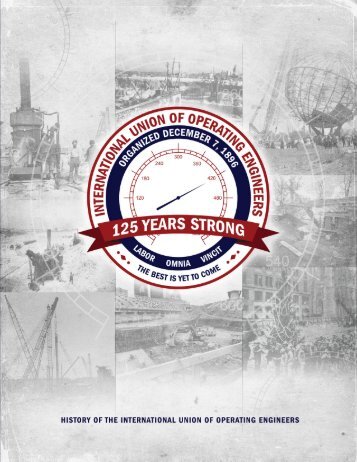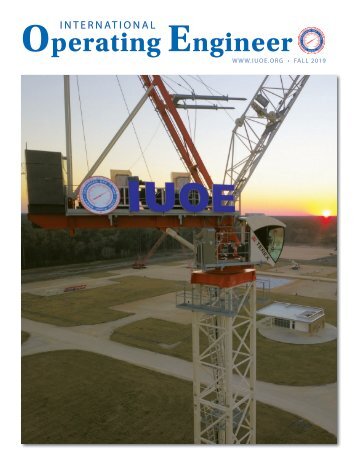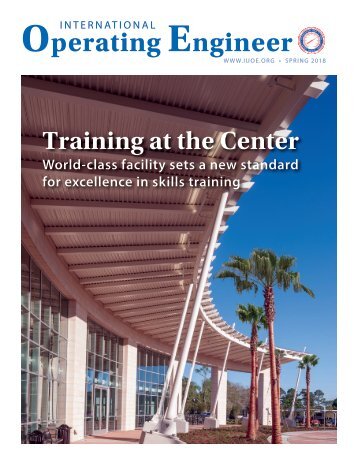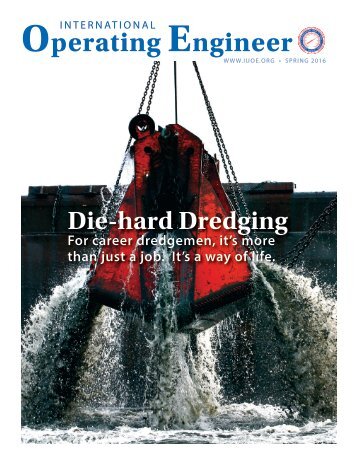125 Years Strong – An IUOE History
- Text
- Wwwiuoeorg
- Vincit
- Omnia
- Engineer
- Convention
- Membership
- Locals
- Operating
- Engineers
INTERNATIONAL UNION OF
INTERNATIONAL UNION OF OPERATING ENGINEERS Messages of support during World War II in the November 1943 issue of the I.U.O.E. International Engineer journal. “After this emergency is over, I want it said that the I.U.O.E. did their part in helping to defend the United States and its possessions.” On the homefront and on battlefields, I.U.O.E. members distinguished themselves throughout the war. Many operating engineers fought courageously in battle, while many others constructed vital bases, airfields, roads and bridges in the war’s European and Pacific theaters as members of the U.S. Army Corps of Engineers or the U.S. Navy Construction Battalions, or “Seabees” as they became famously known. Stationary engineers were also engaged in processing mass amounts of food, clothing, munitions and war materiel in plants throughout North America. When the United States joined the fight, about 12,000 A.F.L. members were employed on defense projects in the Philippines, Wake, Guam and Midway islands, about 400 of which were members of the I.U.O.E. Soon after, communication was lost with about 100 of those operating engineers, and there were no reports as to whether they were alive or held as prisoners of the Japanese. The I.U.O.E. Executive Board in January 1942 provided that all union members in good standing who were prisoners of war would remain members in good standing and be relieved from paying union dues. Back home, among the key wartime projects on which operating engineers were engaged was construction of the Alaska Highway. The 1,671-mile road from Dawson Creek, Canada, to Big Delta, Alaska, constructed to connect the contiguous United States to Alaska across Canada, employed hundreds of operating engineers between March 9 and October 28, 1942. Mississippi River crossing – were let to union contractors, and in an attempt to organize workers on the remainder of the line, Local No. 513 of St. Louis and union steamfitters, teamsters and laborers unsuccessfully went on strike against the crucial Mississippi River portion in the summer of 1943. The action turned violent at times and resulted in the deaths of two people and injuries to many others before the War Labor Board intervened and ended the strike. The Manhattan Project, the government’s research and development program that during World War II produced the first nuclear weapons ever used, also employed large numbers of I.U.O.E. members. Related projects on which operating engineers worked beginning in 1942 included construction of the Hanford Site in the State of Washington, home to the first full-scale plutonium production reactor in the world; Los Alamos National Laboratory in New Mexico, created for the design of nuclear weapons; and Clinton Engineer Works (soon SS Arthur M. Huddell WARTIME SHIP SALUTED PRESIDENT The United States government posthumously honored former I.U.O.E. General President Arthur M. Huddell, who led the union from June 1921 until his death in June 1931, for his efforts on behalf of labor by commissioning the liberty ship SS Arthur M. Huddell in December 1943 during World War II. Initially carrying explosives from the United States to Europe, during much of the war the ship transported materials for Operation PLUTO, the construction of a fuel pipeline under the English Channel to supply allied forces in Europe after the June 1944 D-Day landings in Normandy, France. So-called “Liberty Ships” were EC2-type vessels built with a standardized design and prefabricated parts for emergency mass production by the U.S. Maritime Commission during World War II. The program produced 2,711 Liberty Ships, which were named after prominent deceased Americans, starting with Patrick Henry and the signers of the Declaration of Independence. The St. Johns River Shipbuilding Company in Jacksonville, Florida, erected the S.S. Arthur M. Huddell beginning October 25, 1943, in just 43 days, with six operating engineers taking part in the construction. The 10,500-ton vessel was christened by Brother Huddell’s widow and launched on December 7, after which it was outfitted for duty in just 10 days. Brother Huddell was a founding member of the forerunner to I.U.O.E. Local No. 4 of Boston in the late 1800s and, subsequently, helped form the I.U.O.E. when it was first organized as the National Union of Steam Engineers on December 7, 1896. He served as his local’s business manager, playing a significant role in the 1895 passage of legislation in Massachusetts that regulated steam engineering to make it safer, and he was president of the Boston Central Labor Union in addition to leading his international union. For the remainder of the Second World War and immediately afterwards, the SS Arthur M. Huddell carried coal, general cargo and personnel between the United States and Europe. In 1956, AT&T used the ship to lay undersea communication cable, and during the Cold War, it laid cable for the Navy’s Sound Surveillance System. The ship was decommissioned in 1984 and by the end of the 20 th century was one of only three Liberty Ships still afloat. In 2008, it was transferred to Greece (which had purchased a large number of Liberty Ships from the U.S. government following the war to replenish its maritime fleet), where it was restored in 2010 and continues to serve as a museum ship in Piraeus Harbour in Athens in 2020. That year, construction of the “Big Inch” and the parallel “Little Big Inch” pipelines for transporting heating oil and gasoline from Texas to the northeast states also began employing I.U.O.E. members. However, only two sections of the lines – New Jersey and the SS Arthur M. Huddell (Photo courtesy of Project Liberty Ship, Inc.) LABOR OMNIA VINCIT WORK CONQUERS ALL
- Page 2: LABOR OMNIA VINCIT WORK CONQUERS AL
- Page 6: INTERNATIONAL UNION OF OPERATING EN
- Page 10: INTERNATIONAL UNION OF OPERATING EN
- Page 14: INTERNATIONAL UNION OF OPERATING EN
- Page 18: INTERNATIONAL UNION OF OPERATING EN
- Page 22: INTERNATIONAL UNION OF OPERATING EN
- Page 26: INTERNATIONAL UNION OF OPERATING EN
- Page 30: INTERNATIONAL UNION OF OPERATING EN
- Page 34: INTERNATIONAL UNION OF OPERATING EN
- Page 38: INTERNATIONAL UNION OF OPERATING EN
- Page 42: INTERNATIONAL UNION OF OPERATING EN
- Page 48: INTERNATIONAL UNION OF OPERATING EN
- Page 52: INTERNATIONAL UNION OF OPERATING EN
- Page 56: INTERNATIONAL UNION OF OPERATING EN
- Page 60: INTERNATIONAL UNION OF OPERATING EN
- Page 64: INTERNATIONAL UNION OF OPERATING EN
- Page 68: INTERNATIONAL UNION OF OPERATING EN
- Page 72: INTERNATIONAL UNION OF OPERATING EN
- Page 76: INTERNATIONAL UNION OF OPERATING EN
- Page 80: INTERNATIONAL UNION OF OPERATING EN
- Page 84: INTERNATIONAL UNION OF OPERATING EN
- Page 88: INTERNATIONAL UNION OF OPERATING EN
- Page 92: INTERNATIONAL UNION OF OPERATING EN
- Page 96:
INTERNATIONAL UNION OF OPERATING EN
- Page 100:
INTERNATIONAL UNION OF OPERATING EN
- Page 104:
INTERNATIONAL UNION OF OPERATING EN
- Page 108:
INTERNATIONAL UNION OF OPERATING EN
- Page 112:
INTERNATIONAL UNION OF OPERATING EN
- Page 116:
INTERNATIONAL UNION OF OPERATING EN
- Page 120:
INTERNATIONAL UNION OF OPERATING EN
- Page 124:
INTERNATIONAL UNION OF OPERATING EN
Inappropriate
Loading...
Mail this publication
Loading...
Embed
Loading...
International Operating Engineer
HEADQUARTERS
INTERNATIONAL UNION OF OPERATING ENGINEERS (IUOE)
1125 17th Street, NW
Washington, DC 20036
202 429-9100
CONTACT US
Send us an email here.
©2010 International Union of Operating Engineers. All Rights Reserved.|Terms Of Use|Privacy Statement|Sitemap



















